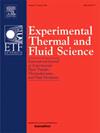Normalization of wettability and heat transfer coefficient curve prediction model on biphilic surfaces
IF 2.8
2区 工程技术
Q2 ENGINEERING, MECHANICAL
Experimental Thermal and Fluid Science
Pub Date : 2025-01-29
DOI:10.1016/j.expthermflusci.2025.111427
引用次数: 0
Abstract
The application of “biphilic surfaces” in boiling heat transfer has attracted widespread attention, and scholars have conducted numerous experimental studies in this field. Unfortunately, the relevant theoretical research is almost blank, especially in predicting essential parameters such as HTC. Therefore, it is necessary to develop a new correlation for the HTC of biphilic surfaces in boiling heat transfer. Firstly, in this study, biphilic surfaces composed of pure copper and Ag(S(CH2)17CH3) were prepared using standard photolithography and chemical etching techniques. All of the surfaces feature 1000 μm square patterns, but there are variations in the contact angles (120.4°, 124.5°, 130.3°, 135°, 140°) of the hydrophobic surfaces. The maximum critical heat flux was 1203.5 kW/m2, and the maximum heat transfer coefficient was 77.8 kW/m2K. Secondly, this study proposed the characteristic contact angle θchar, which solves the issue of representing the wettability of biphilic surfaces with two contact angles. Next, the paper verified reliability of normalization process by combining the theory of homogeneous surfaces. Finally, this paper analyzed the undetermined coefficients in Rohsenow’s correlation by θchar, enabling the prediction of HTC for biphilic surfaces. Compared with experimental data, the maximum prediction error does not exceed 24.13 %.
双亲表面润湿性归一化及传热系数曲线预测模型
“亲双表面”在沸腾传热中的应用引起了广泛的关注,学者们在这一领域进行了大量的实验研究。遗憾的是,相关的理论研究几乎是空白,特别是在预测基本参数,如HTC。因此,有必要建立一种新的沸水传热中双亲表面热交换率的关系式。首先,本研究采用标准光刻和化学蚀刻技术制备了纯铜和Ag(S(CH2)17CH3)双亲表面。所有表面都具有1000 μm的正方形图案,但疏水表面的接触角(120.4°,124.5°,130.3°,135°,140°)存在差异。最大临界热流密度1203.5 kW/m2,最大换热系数77.8 kW/m2K。其次,本研究提出了特征接触角θchar,解决了用两个接触角表示亲水性表面润湿性的问题。其次,结合均匀曲面理论,验证了归一化过程的可靠性。最后,通过θchar对Rohsenow相关中的待定系数进行了分析,实现了双亲表面HTC的预测。与实验数据比较,最大预测误差不超过24.13%。
本文章由计算机程序翻译,如有差异,请以英文原文为准。
求助全文
约1分钟内获得全文
求助全文
来源期刊

Experimental Thermal and Fluid Science
工程技术-工程:机械
CiteScore
6.70
自引率
3.10%
发文量
159
审稿时长
34 days
期刊介绍:
Experimental Thermal and Fluid Science provides a forum for research emphasizing experimental work that enhances fundamental understanding of heat transfer, thermodynamics, and fluid mechanics. In addition to the principal areas of research, the journal covers research results in related fields, including combined heat and mass transfer, flows with phase transition, micro- and nano-scale systems, multiphase flow, combustion, radiative transfer, porous media, cryogenics, turbulence, and novel experimental techniques.
 求助内容:
求助内容: 应助结果提醒方式:
应助结果提醒方式:


